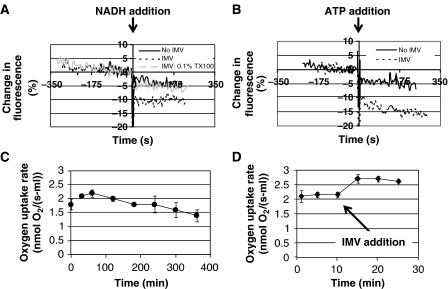Figure 4.
The Cytomim system provides a chemical environment conducive for oxidative phosphorylation. Quinacrine, a self-quenching fluorescent dye that distributes according to pH, was used to indicate the proton pumping capability of IMVs. (A) When NADH is added to IMVs to initiate proton pumping, a 10% drop in fluorescence signal is observed, consistent with pH-induced quinacrine accumulation inside vesicles. This drop in fluorescence is not seen when vesicles are absent from the solution. As an additional control, the experiment was repeated with vesicles in the presence of 0.1% Triton X-100 detergent (TX100). Triton X-100 dissolves lipid bilayers and is shown here to prevent accumulation of protons or quinacrine. (B) Similar to NADH, we observe a drop in fluorescence when proton pumping through the F1FO-ATPase is initiated by ATP addition. (C) Oxygen uptake rate of the Cytomim/glutamate-phosphate/NMP system during synthesis of CAT. Results are the average of n=3 experiments. Error bars=1 s.d. (D) Addition of purified inner membrane vesicles to the Cytomim/glutamate-phosphate/NMP system during synthesis of CAT increases the oxygen uptake rate. At 10 min after the start of the reaction, 0.26 mg of purified inner membrane vesicles were added to the reaction, increasing the total vesicle concentration from 0.26 to 0.36 mg/ml. Results are the average of n=3 experiments. Errors bars=1 s.d.

